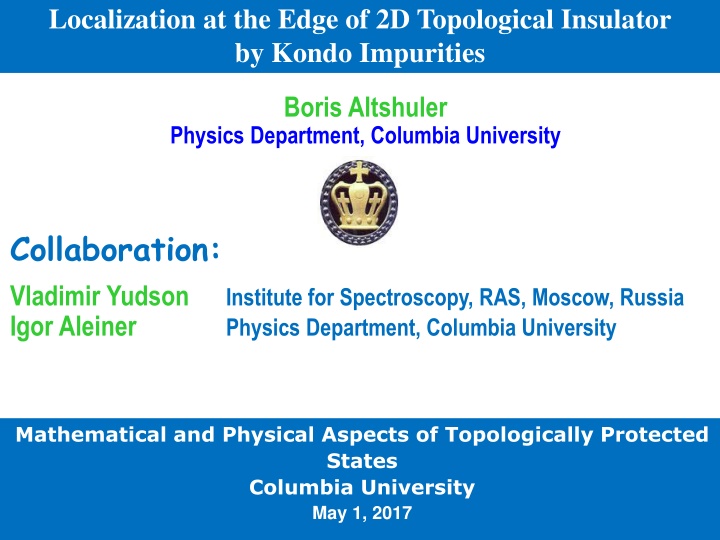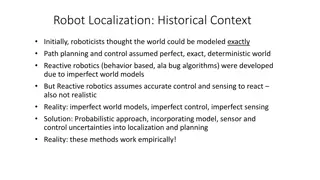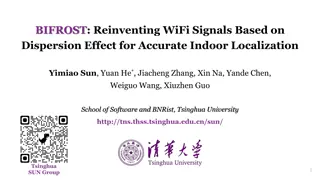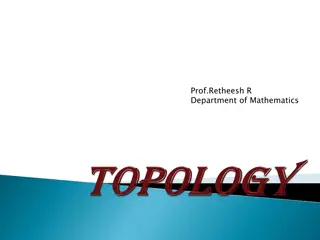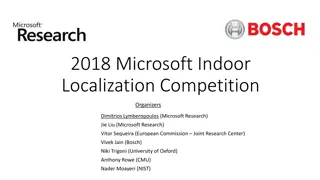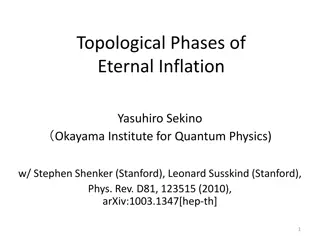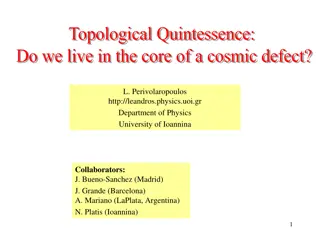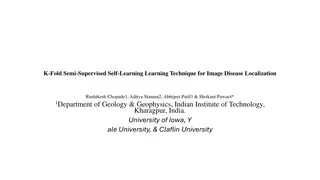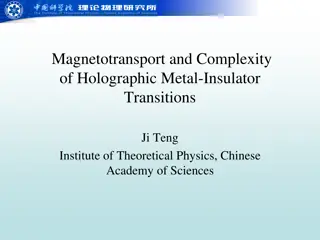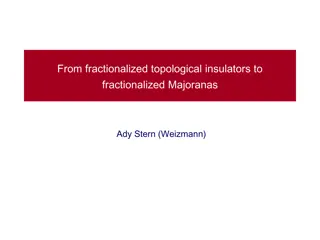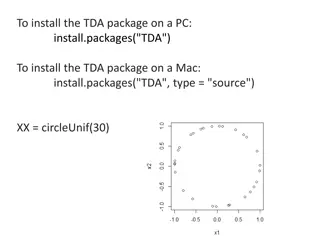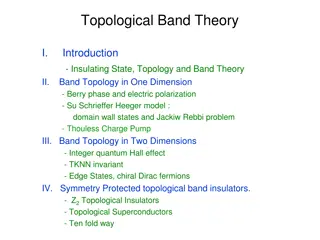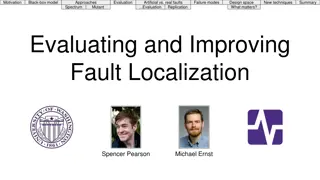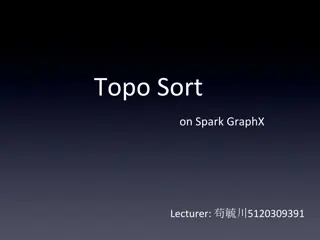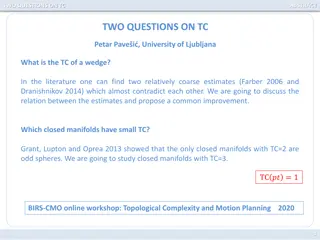Localization at the Edge of 2D Topological Insulator Studies
Study explores mathematical and physical aspects of topologically protected states in 2D topological insulators. Focus on localization behavior at the edge, impact of Kondo impurities, insights into chiral edge states, and resistance to disorder. Discussions on chiral edge states, backscattering, and Kramers degeneracy contribute to understanding the unique properties of these systems.
Download Presentation

Please find below an Image/Link to download the presentation.
The content on the website is provided AS IS for your information and personal use only. It may not be sold, licensed, or shared on other websites without obtaining consent from the author.If you encounter any issues during the download, it is possible that the publisher has removed the file from their server.
You are allowed to download the files provided on this website for personal or commercial use, subject to the condition that they are used lawfully. All files are the property of their respective owners.
The content on the website is provided AS IS for your information and personal use only. It may not be sold, licensed, or shared on other websites without obtaining consent from the author.
E N D
Presentation Transcript
Localization at the Edge of 2D Topological Insulator by Kondo Impurities Boris Altshuler Physics Department, Columbia University Collaboration: Vladimir Yudson Igor Aleiner Institute for Spectroscopy, RAS, Moscow, Russia Physics Department, Columbia University Mathematical and Physical Aspects of Topologically Protected States Columbia University May 1, 2017
2D Topological Insulator Kane and Mele (2005); Bernevig, T. L. Hughes, and S. C. Zhang (2006) CdTe-HgTe-CdTe In the balk (inside the plane) gap in the spectrum of charge excitations insulator At the edge excitations are gapless 1D metal Insensitive to any static disorder topological protection.
2D Topological Insulator Kane and Mele (2005); Bernevig, T. L. Hughes, and S. C. Zhang (2006) CdTe-HgTe-CdTe Hamiltonian of the chiral states at the helical edge ( ) = v k H k x F x z Z-component of the spin Fermi velocity momentum Note: need strong spin-orbital interaction
Electric field U (k ) E Rashba term: k [ ] H U k v k S O F
2D Topological Insulator Kane and Mele (2005); Bernevig, T. L. Hughes, and S. C. Zhang (2006) CdTe-HgTe-CdTe Hamiltonian of the chiral edge states ( ) = v k H k x F x z Z-component of the spin Fermi velocity momentum E Chiral edge states: Left and Right movers xk
1d localization Even a weak disorder is not weak in d=1 ! Mott and Twose (1961): M. E. Gertsenstein and V. B. Vasiliev, Wave guides with random inhomogeneities and Brownian motion in the Lobachevsky plane , Theory of Probability & Its Applications, 1959, Vol. 4, No. 4 : pp. 391-398 Exact Solution! Localization length ~ mean free path Consequence: zero DC conductivity Why all this is not directly applicable to 1D helical edge electrons?
E Chiral edge states: Left and Right movers xk Backscattering would mix the chiral states and thus destroy chirality. One needs spin-flip for the backscattering. E Kramers degeneracy: one needs to violate the time-reversal symmetry to mix left and right movers xk
Basic properties of a generic 2D Topological Insulator: (strong spin-orbit coupling) 2D bulk = insulator: electron spectrum is gapped, levels of impurities are localized Edge Modes are Helical Statement: Time Reversal Symmetry protects Helical Edge Modes from Backscattering and thus from localization by a potential disorder
Quantum Hall Effect Topological Insulator
spatially separated edge states - nowhere to scatter Quantum Hall Effect: Topological Insulator: the back moving state is nearby but the back-scattering can not happen without a spin flip
Topological Insulator: metallic edge Localization at the edge
Time Reversal Symmetry protects Helical Edge Modes from Backscattering and Anderson Localization Conductance of an ideal 1D helical edge should be: 2 2 e = Gideal h
Experimental Observations Large samples show large resistance at the gap. Small samples (~1X1 m) show quantized conductance at the gap, indicating transport by edge states. g: 20-50 L W ( m2) d (nm) I 5.5 20.0 13.3 II 7.3 20.0 13.3 III 7.3 1.0 1.0 IV 7.3 1.0 0.5 Molenkamp s group
Problems with the interpretation: Why the quantization of the conductance takes place only in short samples? L W ( m2) d (nm) NO I 5.5 20.0 13.3 II 7.3 20.0 13.3 NO YES ? III 7.3 1.0 1.0 IV 7.3 1.0 0.5 YES Molenkamp et al.
Time Reversal Symmetry protects Helical Edge Modes from Backscattering and Anderson Localization Conductance of an ideal 1D helical edge should be: 2 2 e = Gideal h In reality, conductance of only extremely small fraction of short samples is somewhat close to , while for most of the short samples and all of the long samples ideal G G G ideal
Problems with the interpretation: Why the quantization of the conductance takes place only in short samples? L W ( m2) d (nm) NO Magic of the log scale I 5.5 20.0 13.3 II 7.3 20.0 13.3 NO YES III 7.3 1.0 1.0 IV 7.3 1.0 0.5 YES
Problems with the interpretation: Why the quantization of the conductance takes place only in short samples? Molenkamp group Yacoby group Harvard reproducible The same sample ! Why the accuracy of the quantization is so poor? Impressive only in the log scale
Questions: How universal is the protection? Can the topological protection be softened? Can helical edge electrons be localized? Role of many-body effects?
Time Reversal Symmetry can be trivially broken by an External Magnetic Field (k ) E k B Spatially homogeneous field no effect! Modulated field > energy gap Homogeneous field + potential disorder = backscattering! Q: ~ cos(2 ) kx ? What about intrinsic sources of the Time Reversal Symmetry Violation
Formation of the Kondo Spins Origin: 1. Chemistry: dangling bonds, etc. 2. Disorder + e-e interaction Localized energy levels close to the edge In the presence of disorder the edge is not single connected.
Formation of the Kondo Spins No e-e interactions: Only empty or double occupied localized states Hubbard repulsion or Single occupied states spins
Localized Spins in the presence of itinerant electrons = Kondo Spins Origin: 1. Chemistry: dangling bonds, etc. 2. Localized energy levels close to the edge Onsite Hubbard repulsion Anderson Impurity Model 4 states of each localized level. Different energies (Anderson, 1961) Ec Ec energy of the repulsion { E0-E1E2-E1 Chemical potential E0 > E1 E2 > E1 Ec> E=0
Anderson Model Kondo Model or Interaction between the itinerant electrons and the Kondo Spins ( ) ( ( ) ( ) ) + + = = + + H J S r r J S S S r r eS e S z z e S
Interaction between the itinerant electrons and the Kondo Spins ( ) ( ( ) ( ) ) + + = = + + H J S r r J S S S r r eS e S z z e S or Kondo Effect Screening of the localized spins
Magnetic (spin) impurity near the helical edge single electron impurity + + = z z x x y y 1) ( : ( ) U J S J S S Electron-spin interaction: electron spin || z J S + + || = + + z ( ) J S S S impurity spin z z 2 U(1)-symmetry: symmetry under rotation around z-axis in the spin space = conservation of the z-component of the total spin No influence on the T = 0 dc charge transport Reasons:
U(1) - symmetric (xy-isotropic) electron-spin interaction has no influence on T=0 dc transport 1. Kinematic reason Maciejko, Liu, Oreg, Qi, Wu, Zhang (2009) Tanaka, Furusaki, Matveev (2011) Spin down impurity can back-scatter a right-moving electron. However, subsequent backscattering of right-moving electrons is impossible until some left-moving electron reverse the impurity spin! The impurities can effect ac conductivity but not dc one! Reason: conservation of , i.e. U(1)-symmetry Sz
U(1) - symmetric (xy-isotropic) electron-spin interaction has no influence on zero-temperature dc charge transport Second reason: Kondo effect - screening of the impurity spin Recovery of the Time Reversal Symmetry Kondo exchange i i e e + 2 2 Does not depend on the U(1)-symmetry
RKKY interaction of localized spins cos[2 r ] S S F jk k r 2 J v j k H S S d j k F jk r r r d number of dimensions jk j k Finite density of spins competition between the Kondo effect and RKKY interaction of the spins S. Doniach (1977)
Single spin: T-invariance always survives due to the Kondo effect Finite density of spins: T-invariance can be violated spontaneously (Kondo RKKY) but the backscattering would not appear as long as z- component of the total spin is conserved = the system remains U(1)-symmetric, i.e. invariant under rotations in spin space around z-axis. What if there is a small but finite density of localized and anisotropic spins ? Q: + + z z x x y y (1): ( ); U J S J S J S J J z x y x y
What if there is a small but finite density of localized and anisotropic spins ? Q: Indirect exchange of the localized spins - RKKY interaction S ( ) jx S+ ( ) kx density of spins Kondo Spin glass RKKY electron-spin coupling constant Broken T-invariance T-invariant Spontaneous breaking of the time-reversal symmetry
Magnetic anisotropy is not conserved U(1) No magnetic anisotropy U(1) is conserved tot zS tot zS No Perfect 1D metal Band Insulator: Charged excitations are gapped even at the edge disorder (regular spin chain) = 2 2e h Anderson Insulator: Edge states are localized Goldstone mode perfect 1D metal 2e h = Disorder 2
It is as difficult to preserve U(1) symmetry as to preserve translation invariance
Magnetic anisotropy is not conserved U(1) No magnetic anisotropy U(1) is conserved tot zS tot zS No Perfect 1D metal Band Insulator: Charged excitations are gapped even at the edge disorder (regular spin chain) = 2 2e h Anderson Insulator: Edge states are localized = Goldstone mode perfect 1D metal 2e h = Disorder 2 0
Effect of the environment cannot be reduced to an external noise. The most important is the appearance of the additional degrees of freedom. As a result the Hilbert space is increased, which can easily destroy the topology.
Helical edge Insulating bulk Localized spins Right mover Spin up Left mover Spin down Helical edge z ~? y x Localized spin impurities located at + , x x x , j S 1 j j j j Linear spin density = ( ) ( ; ) j x x x S 1 Averaged spin density: ( ) x S S a
Hamiltonian: H H = Electron operator: 1 ( ) 2 + ik x e e H F = R x e e S ik x F L Free helical electrons: 0 x = = ( ) x ( ) x H iv dx e F 0 x = R L ( ) x ( ) x iv dx F x x ( ) ( ) ( ) ( ) R L
Hamiltonian: H H = Electron operator: 1 ( ) 2 + ik x e e H F = R x e e S ik x F L Free helical electrons: 0 x = = ( ) x ( ) x H iv dx e F 0 x = R L ( ) x ( ) x iv dx F x x ( ) ( ) ( ) ( ) R L Electron-spin interaction: : ) 1 ( U - electron spin ( ) = add + + = z x y ( ) J S J S S ) 1 ( U : || z z x y J J + + ( ) S S + || = + + z ( ) J S S S + 2 + z z 2 = + ( ) 2 J J J = ( ) 2 J J J J || x y || x y
Hamiltonian: H H = Electron operator: 1 ( ) 2 + ik x e e H F = R x e e S ik x F L Free helical electrons: 0 x = = ( ) x ( ) x H iv dx e F 0 x = R L ( ) x ( ) x iv dx F x x ( ) ( ) ( ) ( ) R L Electron-spin interaction: : ) 1 ( U - electron spin ( ) = add + + = z x y ( ) J S J S S ) 1 ( U : || z z x y J J + + ( ) S S + || = + + z ( ) J S S S + 2 + z z 2 = + ( ) 2 J J J = ( ) 2 J J J J || x y || x y Note: the Hamiltonian is T-invariant
: ) 1 ( U Electron-spin interaction ( ) ( ) J 2 j 2 2 ik x ik x + R + L + j + L j + R || = + + z e e H J S S S F j F j e S z ( ) ( ) ( ) ( ) ( ) ( ) ( ) ( ) R L R L Effective spin-spin ( RKKY ) interaction S ( ) jx S+ ( ) kx Helical (chiral) electrons Usual (non-chiral) electrons 2 ( ) ik x x + j k + 2 || e . . J S S h c F j k cos[ 2 ( )] S S k x x 2 J j j = H j k F j k H S S S S 8 | | v x x | | v x x k k F j k F j k
: ) 1 ( U Electron-spin interaction ( ) ( ) J 2 j 2 2 ik x ik x + R + L + j + L j + R || = + + z e e H J S S S F j F j e S z ( ) ( ) ( ) ( ) ( ) ( ) ( ) ( ) R L R L Effective spin-spin ( RKKY ) interaction S ( ) jx S+ ( ) kx Helical (chiral) electrons Usual (non-chiral) electrons 2 ( ) ik x x + j k + 2 || e . . J S S h c F j k cos[ 2 ( )] S S k x x 2 J j j = H j k F j k H S S S S 8 | | v x x | | v x x k k F j k F j k Features of chirality: 1. No interaction k S Can be removed by S S = z jS z 2 ik x e S F j j j j 2 ( ) 2 ik x x ik x 2.Factorization instead of e = 2 ik x e e F i j F j cos[ 2 ( )] F i k x x F j j
Helical edge Insulating bulk Localized spins Helical edge y z x 2 ik Fx e S S j j j black red
2 ik x S = e j S Ferromagnet (rather than Spin Glass) without mean magnetization (Mattis model of spin glass) F j j 2F k x j Effective spins with ferromagnetic exchange interaction + + 2 || v . . | S S hc x J j k = ( S S ) eff H 8 | x j k F j k Helical edge Insulating bulk Localized spins Right mover Spin up Left mover Spin down Helical edge z ~? y x
Coherent representation of the spins: 1 2 = ; | | 1 n S n j j j z j jS is parametrized by and n , j z n zn 1 2 1 2 S i 2 z j z j ; 1 e S n S n j , , z j j y 2 1 cos zn 2 1 sin zn x Wess, Zumino. (1971). Witten. (1983)
z n zn S y 2 1 cos zn 2 1 sin zn x zn Need to 1. Integrate over 2. Integrate over 3. Take into account the chiral anomaly ( ) x u v = K 1 1 ( ) x dx d ( ) ( ) 2 2 F S = + u S x K u J 2 E || = ln u B 0 2
Matsubara Action (U(1)-symmetric) = ik x e e 1 F ( ) x dx d ( ) ( ) = S L L R x + ik x S e S S 2 F L 0 2 z i 1 n e = iv + L = F x e S 2 z i 1 n e S J || S = ) 2 L = ( , ) ( , ) 1 iS n x x S z ( = ,x const Note: if then the electrons are gapped! Gauge transformation to account for variations of i i = = e , e 2 2 ( ) ( ) ( ) ( ) R R L L i i = = e , e 2 2 ( x , ) ( ) ( ) ( ) ( ) R R L L + 2 z 2 1 i n + L = e S + + 2 z 1 2 n i
Mapping for isotropic exchange Free chiral edge electrons Electron-spin exchange U(1) - symmetry J E || = ln u v B F 2 S J || S Effective velocity Luttinger Liquid with small velocity and small Luttinger parameter u v = 1 K F Luttinger parameter 1 = Ideal Metallic Conductance even in the presence of a potential disorder el x 2 Bosonic field Goldstone mode
Mapping for anisotropic exchange J J Electron-spin interaction: + + + + j ||( 2 Anisotropy of j-th spin + + + ) ( ) S S S S j j j j j j j j 2 J j If is independent of j, then the spectrum is gapfull 4 ik x j e F j j J || j More likely is random! = d k j jk Measure of the U(1) breaking disorder Continuous limit ( ) x ( ) x ( ) x ( ) = d x x j S
Matsubara Action (broken U(1)-symmetry) Electron-spin interaction: J J + + + + j ||( 2 + + + ) ( ) S S S S j j j j j j j j 2 J 4 ik x j e F j j J || Modified boson action: v ( , ) x [ ] S d dx + + 2 2 2 2 i [( ) ( ) ] Re ( )e x u F u x 2 8
Mapping for anisotropic exchange v ( ( , ) x [ ] S d dx + + 2 2 2 2 i [( ) ( ) ] Re ( )e x u F u x 2 8 ( ) ) *( ) ( ') x = ( ') x d x x ||exp 4 J J ik x S j j F j Mapping on the problem of the pinning of one-dimensional charge-density wave by potential disorder. Localization length (Giamarchi & Schulz, 1988 ) 12 J aE J || = ln u v B 1 F 2 2 3 2 K K 2 || 2 3 K v J aE J = ln L a d F B u v loc = 1 K || || F
